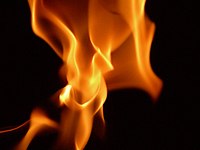
Photo from wikipedia
Abstract Numerical simulations of counterflow laminar diffusion flames impinged by sub-breakdown DC electric fields are performed in this work using multi-component transport and a detailed chemical mechanism for methane–air combustion… Click to show full abstract
Abstract Numerical simulations of counterflow laminar diffusion flames impinged by sub-breakdown DC electric fields are performed in this work using multi-component transport and a detailed chemical mechanism for methane–air combustion that includes elementary steps for the conversion of six electrically charged species. The electric field is induced by two electrodes located on the oxidizer and fuel sides and arranged parallel to the mixing layer in a configuration resembling the one recently studied experimentally by Park et al. (2016) [1], which unveiled significant electric-field effects on the aerodynamics. In these simulations, the electric drift of the charged species leads to a bi-directional ionic wind that is axially directed toward both injectors. The major components of the ionic winds are the H 3 O + and O 2 − ions, which are steered by the electric field into the fuel and oxidizer streams, respectively. At sufficiently high electric fields of the order of a few kilovolts per centimeter, the ionic wind intricately couples with the aerodynamic field of neutral molecules flowing into the burner, in a manner that ultimately leads to non-negligible disturbances of the velocity field. The overall effect of these interactions consists of a decrease in the local strain rate and in the stoichiometric scalar dissipation rate, which increases the burning rate of the diffusion flame. The functional form of the scalar dissipation rate depends on the applied electric field, which may have consequences for the subgrid-scale modeling of these processes. In contrast to electrified one-dimensional premixed flames, here the current ceases to vary monotonically with the voltage as a result of the coupling with the aerodynamic field. Comparisons between the present numerical simulations and the experiments performed by Park et al. (2016) [1] are made that indicate qualitative agreement. Quantitative disagreements related to the saturation intensities and to the strength of the electric disturbances of the velocity field are discussed, and possible sources of these discrepancies are identified.
Journal Title: Combustion and Flame
Year Published: 2018
Link to full text (if available)
Share on Social Media: Sign Up to like & get
recommendations!